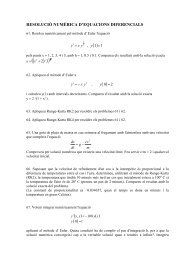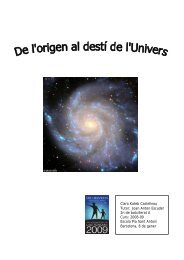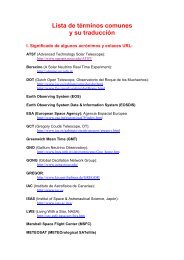Universitat de - Departament d'Astronomia i Meteorologia ...
Universitat de - Departament d'Astronomia i Meteorologia ...
Universitat de - Departament d'Astronomia i Meteorologia ...
Create successful ePaper yourself
Turn your PDF publications into a flip-book with our unique Google optimized e-Paper software.
142 Chapter 5. Radio and optical observations<br />
The optical emission seen in microquasars arises from the non-<strong>de</strong>generated star<br />
of the system, i.e., the companion of the compact object. Hence, in microquasars<br />
containing a high mass companion spectral types O or B are found, while in those<br />
containing a low mass companion the spectral type is later than A (White et al.<br />
1995). Therefore, as optical counterpart of a given candidate, we expect to find a<br />
non-<strong>de</strong>generated star with any spectral type, and with a luminosity class ranging<br />
from the main sequence to supergiant. In fact, once photometric magnitu<strong>de</strong>s of an<br />
object through different filters and its distance are known, one can easily <strong>de</strong>duce<br />
its spectral type assuming it is a star. However, we have no information about the<br />
distance to our sources, and no correction for extinction can be applied to our data.<br />
This is particularly important in our case, since our search has been carried out at<br />
low galactic latitu<strong>de</strong>s, where a high <strong>de</strong>gree of extinction is expected, preventing any<br />
spectral type classification from the photometric data alone.<br />
5.4.1 Discussion on individual sources<br />
1RXS J001442.2+580201. The radio counterpart, see Table 5.1, shows a mod-<br />
erate <strong>de</strong>gree of variability but always displaying a negative spectral in<strong>de</strong>x of ∼ −0.2,<br />
suggesting an optically thin or partially self-absorbed synchrotron emitter. As can<br />
be seen in Fig. 5.2, the non-simultaneous NVSS flux <strong>de</strong>nsity measurement at 20 cm<br />
wavelength is compatible with this behavior or even with a flattening of the spec-<br />
trum at longer wavelengths, although this could be due to intrinsic variability. Non-<br />
thermal synchrotron radiation remains therefore as the most plausible interpretation<br />
for the radio emission of this source. The optical counterpart to the radio source<br />
(Fig. 5.1) appears as a point-like source with I ∼ 20, which makes it the weakest<br />
optical object of our sample. No R or V magnitu<strong>de</strong>s could be obtained, although<br />
a typical behavior for low latitu<strong>de</strong> highly absorbed sources is an increase of ∼ 1<br />
magnitu<strong>de</strong> when changing from I to R and from R to V , as can be seen in the other<br />
sources of Table 5.2. All the available information points towards a good REXB<br />
candidate.<br />
1RXS J013106.4+612035. In the radio domain it shows a slightly negative or<br />
close to zero spectral in<strong>de</strong>x, reminiscent of optically thin or partially self-absorbed<br />
jets in REXBs, in which the non-simultaneous NVSS flux measurement fits well, and<br />
it displays a very low <strong>de</strong>gree of variability of 2% at 3.6 cm and 4% at 6 cm. This






